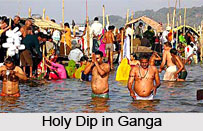 In 1886, during a meeting in Hardwar, the Gau Varnashrama Hitaishini Ganga Dharma Sabha was formed. The English translation of the Sabha was made as the Religious Association for the Benefit of the Cow, Social Order, and the Holy Ganges. The urgent issue that motivated this organization depended on the boxes set up along the banks of the Ganges by the Arya Samaj. After the pilgrims had bathed in the river, they dropped donations into these holders.
In 1886, during a meeting in Hardwar, the Gau Varnashrama Hitaishini Ganga Dharma Sabha was formed. The English translation of the Sabha was made as the Religious Association for the Benefit of the Cow, Social Order, and the Holy Ganges. The urgent issue that motivated this organization depended on the boxes set up along the banks of the Ganges by the Arya Samaj. After the pilgrims had bathed in the river, they dropped donations into these holders.
This new society very soon elected officers, established its own organization, and encouraged the priests of Hardwar to end this practice that allowed their enemies to profit from orthodox rituals. Then the groups started a discussion related to the respect for the holy Ganga (i.e. the Ganges River), cows, Brahman priests, and places of pilgrimage. There was no disagreement to the fact that Hindus were divided and so thus there was a necessity to attempt to create a greater degree of unity, and that they must work for the protection of sanatana dharma. At the close of this first meeting, the new society had built an organizational configuration with officials, a headquarters in Hardwar, and a set of published rules. The Sabha very soon articulated the view of Brahman priests as to the type of social and cultural tasks facing them and their associates, but little else was accomplished.
After the Hardwar meeting, Din Dayalu traveled widely organizing Sanatana Dharma Sabhas, goshalaas (homes for cattle), and Sanskrit schools. He toured Punjab, the Gangetic plain, and went as far east as Calcutta. During this tenure, he and others spoke of finding an organization with broader goals, one that would symbolize all Hindus. At a meeting held in April 1887 in the Princely State of Kapurthala, a small group of Din Dayalu`s associates attached to him came together and planned a new organization, the Bharat Dharma Mahamandala, with the purpose of bringing together all leaders of the orthodox Hindu community. A welcoming committee was thus formed with Pandit Din Dayalu as its chairman. It met in Hardwar on 4 May 1887, distributed letters and circulars thus declaring the new society, and the date of their first meeting in 1887. They invited individuals to attend their meeting and suggested that anyone with a question concerning the Vedas, Shastras, Puranas, or other Hindu scripture should submit it in writing so that the assembled priests could answer it.
The first gathering of the Mahamandala was set for the Hindu holy day, Ganga Dashami. During this time, Hardwar was filled with pilgrims; practices like ritual bathing, numerous speeches and the passing of resolutions could be seen. These focused onto protect varndshramadharma, the traditional pattern of religious duties as expressed in the caste system, on the necessity for religious preaching, for Sanatana Dharma Sabhas, and for the defence of Hinduism from critics both within the community and outside of it. Din Dayalu spoke on the requirement for Sanskrit schools and for Hindi to be the language of education and administration. The Mahamandala eventually agreed to send out updeshaks or the paid missionaries to propagate its goals and act to tie this organization with local Sanatana Sabhas. This first meeting ended with great enthusiasm and rehabilitated the hope that orthodoxy could protect itself in an era of lethargy and immorality. Members of the ruling Hindu aristocracy, landowners, priests, heads of Hindu societies and also the theosophists who were represented by Colonel Olcott carried out the Mahamandala.
The Mahamandala held its second meeting in 1889, at the Shri Govinda Deva temple in Brindaban. This time the proclamation was written in Hindi according to a decision taken at the first meeting to use Hindi for all Mahamandala proceedings. The notice declared that before their first gathering there were fewer than 100 Hindu religious organizations in India, but that in the last two years their number had risen to more than 200. Thus the Mahamandalas carried out their proclamations of the agenda and kept the motive of Hitaishini Ganga Dharma Sabha alive for several years.



















